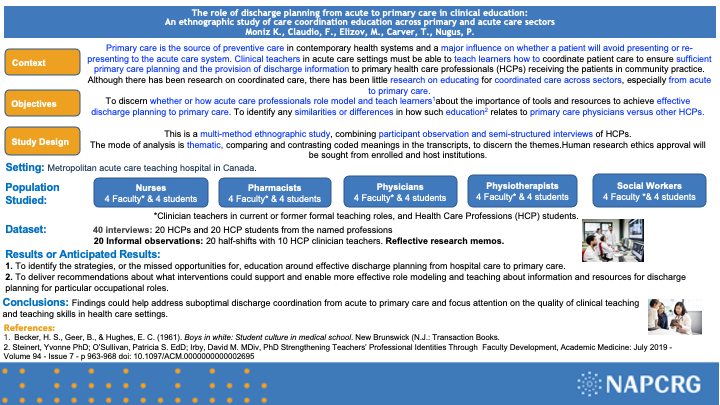SRFP105: The role of discharge planning from acute to primary care in clinical education: An ethnographic study of care coordination
Karen Moniz, MEd, BSc; Peter Nugus, PhD, BA, MA, MEd
Abstract
Objective: 1. To discern whether or how acute care professionals role model and teach learners about the importance of and tools to accomplish effective discharge planning to primary care. 2. To identify any similarities or differences in how such education relates to primary care physicians versus other HCPs.
Study Design: This is a multi-method ethnographic study, combining participant observation and semi-structured interviews of HCPs. The mode of analysis is thematic analysis, comparing and contrasting coded meanings in the transcripts, to discern themes.
Setting or Dataset: The study is being conducted in a relatively typical metropolitan teaching hospital in Edmonton, Alberta, among physicians, nurses, physiotherapists, social workers and pharmacists, and students. 40 interviews will involve 20 HCPs and 20 students. In addition to informal observation, 20 half-shifts will be observed, comprising 10 HCPs. Participants are current and former residency program directors or preceptors, and students of the above-named occupations.
Population Studied: Clinician teachers in current or former formal teaching roles, and HCP students.
Intervention/Instrument (as pertinent): (Not applicable)
Main and Secondary Outcome Measures (if any): (Not applicable)
Results or Anticipated Results: 1. To identify the strategies with which, or the missed opportunities for, education around effective discharge planning to primary care from hospital care. 2. To deliver recommendations about what interventions could support and enable more effective role modeling and teaching about information and resources for discharge planning, including to particular occupational roles.
Conclusions: The problem being addressed is poor care coordination from acute to primary care, and inadequate attention to the quality of clinical teaching in health care setting.

Jack Westfall
jwestfall@aafp.org 11/21/2021Great project and abstract. Thanks for sharing at NAPCRG